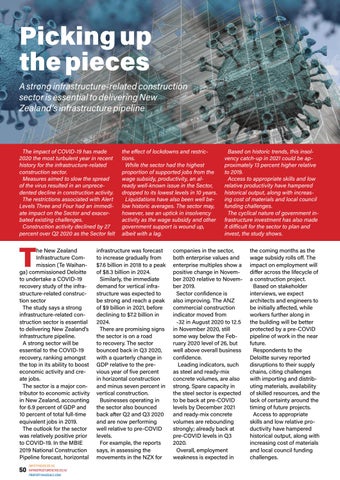April-May 2021
Picking up the pieces
CONSTRUCTION
A strong infrastructure-related construction sector is essential to delivering New Zealand’s infrastructure pipeline
The impact of COVID-19 has made 2020 the most turbulent year in recent history for the infrastructure-related construction sector. Measures aimed to slow the spread of the virus resulted in an unprecedented decline in construction activity. The restrictions associated with Alert Levels Three and Four had an immediate impact on the Sector and exacerbated existing challenges. Construction activity declined by 27 percent over Q2 2020 as the Sector felt
T
he New Zealand Infrastructure Commission (Te Waihanga) commissioned Deloitte to undertake a COVID-19 recovery study of the infrastructure-related construction sector The study says a strong infrastructure-related construction sector is essential to delivering New Zealand’s infrastructure pipeline. A strong sector will be essential to the COVID-19 recovery, ranking amongst the top in its ability to boost economic activity and create jobs. The sector is a major contributor to economic activity in New Zealand, accounting for 6.9 percent of GDP and 10 percent of total full-time equivalent jobs in 2019. The outlook for the sector was relatively positive prior to COVID-19. In the MBIE 2019 National Construction Pipeline forecast, horizontal
50
safetynews.co.nz
infrastructurenews.co.nz propertyandbuild.com
the effect of lockdowns and restrictions. While the sector had the highest proportion of supported jobs from the wage subsidy, productivity, an already well-known issue in the Sector, dropped to its lowest levels in 10 years. Liquidations have also been well below historic averages. The sector may, however, see an uptick in insolvency activity as the wage subsidy and other government support is wound up, albeit with a lag.
infrastructure was forecast to increase gradually from $7.6 billion in 2018 to a peak of $8.3 billion in 2024. Similarly, the immediate demand for vertical infrastructure was expected to be strong and reach a peak of $9 billion in 2021, before declining to $7.2 billion in 2024. There are promising signs the sector is on a road to recovery. The sector bounced back in Q3 2020, with a quarterly change in GDP relative to the previous year of five percent in horizontal construction and minus seven percent in vertical construction. Businesses operating in the sector also bounced back after Q2 and Q3 2020 and are now performing well relative to pre-COVID levels. For example, the reports says, in assessing the movements in the NZX for
Based on historic trends, this insolvency catch-up in 2021 could be approximately 13 percent higher relative to 2019. Access to appropriate skills and low relative productivity have hampered historical output, along with increasing cost of materials and local council funding challenges. The cyclical nature of government infrastructure investment has also made it difficult for the sector to plan and invest, the study shows.
companies in the sector, both enterprise values and enterprise multiples show a positive change in November 2020 relative to November 2019. Sector confidence is also improving. The ANZ commercial construction indicator moved from -32 in August 2020 to 12.5 in November 2020, still some way below the February 2020 level of 26, but well above overall business confidence. Leading indicators, such as steel and ready-mix concrete volumes, are also strong. Spare capacity in the steel sector is expected to be back at pre-COVID levels by December 2021 and ready-mix concrete volumes are rebounding strongly; already back at pre-COVID levels in Q3 2020. Overall, employment weakness is expected in
the coming months as the wage subsidy rolls off. The impact on employment will differ across the lifecycle of a construction project. Based on stakeholder interviews, we expect architects and engineers to be initially affected, while workers further along in the building will be better protected by a pre-COVID pipeline of work in the near future. Respondents to the Deloitte survey reported disruptions to their supply chains, citing challenges with importing and distributing materials, availability of skilled resources, and the lack of certainty around the timing of future projects. Access to appropriate skills and low relative productivity have hampered historical output, along with increasing cost of materials and local council funding challenges.

















